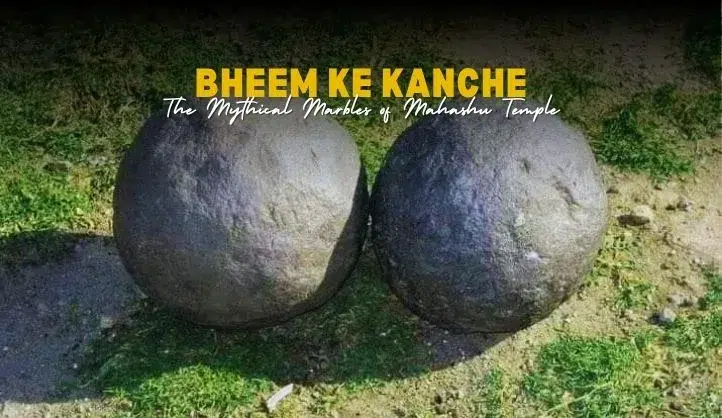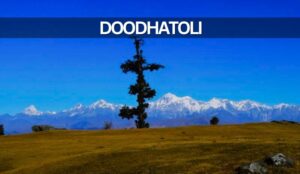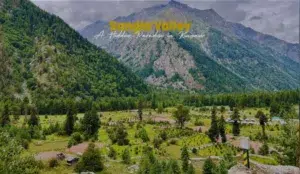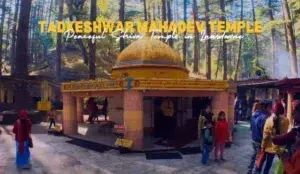In the hills of Hanol, Uttarakhand, lies the revered Mahasu Devta Temple, a sacred site that is not only a symbol of deep faith but also a place steeped in ancient legends. Among the many tales and traditions associated with this temple is one unique and playful myth – Bheem ke Kanche, or “Bheem’s marbles.”
These are not ordinary marbles. Local legends say they once belonged to Bheem, the mighty Pandava brother from the Mahabharata. The round stones, said to be the size of cricket balls and made of granite or heavy rock, are kept safely inside the temple premises and are shown to visitors upon request.
This is a story where mythology meets mystery, and play meets devotion.
Where Is Bheem ke Kanche Found?
Bheem ke Kanche are found in the Mahashu Devta Temple, located in Hanol village, in the Chakrata region of Dehradun district, Uttarakhand. The temple is situated along the banks of the Tons River and surrounded by dense forests.
Inside the ancient temple premises, you can ask the priests to show you these legendary “kanche.” They are not glass marbles like the ones children play with today, but big round stones—believed to be thousands of years old.
Who Was Bheem and What’s His Connection to These Marbles?
In the Indian epic Mahabharata, Bheem is known as the strongest of the Pandava brothers. He was a warrior, a protector, and a fierce devotee of justice.
Local legend in Hanol says that during their exile, the Pandavas visited this region. Bheem, with his immense strength, used to play with huge stone marbles for fun. These stones, according to oral folklore, were left behind and are now preserved at the Mahashu Devta Temple. Thus, they are called “Bheem ke Kanche.”
Some even say Bheem used these stones to train or as weapons, while others believe it was simply a playful act of his divine strength.
What Are Bheem ke Kanche Made Of?
Unlike modern marbles made of glass or ceramic, Bheem ke Kanche are:
-
Large, heavy, and stone-based
-
Made from solid rock
-
Weighing a few kilograms each
-
Smoothly rounded—showing signs of human (or superhuman!) crafting
These stones are considered sacred by the locals and are never moved from the temple complex.
What Is the Mahashu Devta Temple?
The Mahashu Devta Temple is one of the oldest temples in Uttarakhand, dating back to the 9th century CE. It is dedicated to Lord Mahashu, an avatar of Lord Shiva and the ruling deity of the Jaunsar-Bawar region.
What makes the temple special:
-
Built in Kath-Kuni style (wood and stone architecture)
-
Located in a peaceful, forested setting
-
Locals follow ancient divine justice rituals here
-
It plays a major role in the cultural life of nearby villages
Why Are Bheem ke Kanche Significant?
Bheem ke Kanche are not just ancient stones. They hold cultural, spiritual, and emotional value for the local community:
1. Mythological Importance
They link the temple directly to the Mahabharata, one of the two great Hindu epics. This makes the temple an even more powerful site of pilgrimage.
2. Proof of Faith
The existence of such large rounded stones gives believers a physical connection to Bheem’s story. For many, seeing is believing.
3. Symbol of Strength and Innocence
Even though Bheem was known for his strength in battle, the image of him playing marbles shows the softer, more human side of the warrior—bringing joy to the hearts of visitors.
4. Tourist Attraction
Pilgrims and curious tourists alike are fascinated by the legend of Bheem ke Kanche. The story is retold by priests and elders with deep pride.
How to Reach Mahashu Devta Temple
Here’s how you can visit this divine destination:
-
By Road:
Hanol is well connected via road from Dehradun (about 180 km) and Chakrata (about 90 km). It’s a scenic drive through pine forests and river valleys. -
By Rail:
The nearest major railway station is Dehradun Railway Station. From there, you can hire a taxi or take a local bus. -
By Air:
The closest airport is Jolly Grant Airport, Dehradun, about 200 km from Hanol.
Things to Do at Mahashu Devta Temple
Apart from seeing Bheem ke Kanche, here’s what else you can experience:
-
Attend the Annual Mahashu Fair: A grand celebration with rituals, local food, and cultural performances.
-
Explore the Forest Trails: The area around Hanol is great for nature walks and bird watching.
-
Visit the Tons River: A beautiful river perfect for a riverside picnic or quiet meditation.
-
Talk to the Priests: They often share untold stories and oral legends about Bheem, the temple, and more.
Best Time to Visit
-
April to June: Pleasant weather, ideal for sightseeing and exploring nature.
-
September to November: Clear skies, good for attending fairs and enjoying the post-monsoon greenery.
Avoid peak monsoon (July–August), as roads may be blocked due to landslides.
Nearby Attractions
Lakhamandal Temple
A sacred site with ties to the Mahabharata, Lakhamandal Temple is believed to be the location of the legendary Lakshagriha—the house of wax. Devotees flock here to witness the unique Shiva Lingam, which appears larger from a distance than it actually is up close. The ancient ruins, mysterious aura, and mythological background make it a must-visit for history lovers and spiritual travelers.
Kanasar Forest and Meadows
For nature lovers, Kanasar is a dreamy destination. Enveloped by ancient deodar forests and open meadows, it’s a fantastic spot for camping, birdwatching, or simply connecting with nature. The peaceful ambiance and raw natural beauty make it ideal for a relaxed day trip from Hanol or an overnight stay under the stars.
Deoban (Devban)
Located at a high altitude near Chakrata, Deoban offers mesmerizing views of the Himalayan peaks. With dense forests and clear skies, it is perfect for trekking, meditation, or simply soaking in the panoramic mountain views. It’s a quiet retreat for those looking to escape into the wilderness.
Mori Village
Nestled on the banks of the Tons River, Mori is a serene Himalayan village offering stunning natural surroundings and opportunities for adventure. Known for river rafting (seasonal), fishing, and riverside camping, it provides a peaceful escape with the soothing sounds of flowing water and chirping birds.
Tiuni
Just a short drive from Hanol, Tiuni is a small yet lively town that serves as a convenient stop for travelers. It offers local food joints, small guesthouses, and a traditional market, making it a practical place to rest, stock up on supplies, or explore local culture before heading deeper into the hills.
Chakrata
A charming hill station from the colonial era, Chakrata is known for its calm environment, hidden caves, and forest treks. The cool weather, quaint bazaars, and surrounding beauty make it a great base for travelers exploring the Jaunsar-Bawar region. It’s also popular among photographers, bikers, and weekend tourists.
Purola
A peaceful mountain town, Purola is often used as a stopover for treks like Har ki Dun. Surrounded by apple orchards, pine forests, and picturesque mountain views, the town offers a mix of scenic beauty and warm hospitality. It’s a perfect place to slow down and enjoy the local way of life.
Local Beliefs and Customs
In the Mahashu Devta region, faith is a living tradition. The belief in the justice system of Mahashu Devta is so strong that even today, people take vows, resolve disputes, and offer thanks in his name.
The presence of Bheem ke Kanche adds another layer of faith. Many locals believe that if a devotee prays with a pure heart while viewing these stones, Bheem’s strength and protection will guide them through life.
Conclusion: A Legend Worth Witnessing
Bheem ke Kanche is more than just a tale; it’s a fascinating mixture of mythology, folklore, and spiritual tradition. Whether you’re a believer, a traveler, a student of history, or simply someone who enjoys unique stories—this is one worth discovering.
When you stand before the ancient marbles at Mahashu Devta Temple, you don’t just see stones.
You see a timeless connection—to Bheem, to our epics, and to a form of childlike joy and strength that still echoes in these hills.
FAQs – Bheem ke Kanche and Mahashu Devta Temple
1. What are Bheem ke Kanche?
Bheem ke Kanche are large stone marbles believed to have belonged to Bheem, the powerful Pandava brother from the Mahabharata. These are kept inside the Mahashu Devta Temple in Hanol, Uttarakhand.
2. Are visitors allowed to see Bheem ke Kanche?
Yes, visitors can see Bheem ke Kanche upon request. The temple priests usually show them and explain their connection to mythology.
3. Is there any entry fee to visit Mahashu Devta Temple?
No, there is no entry fee to visit the temple. However, donations are welcome and used for temple upkeep.
4. What is the best time to visit Mahashu Devta Temple?
The best time is from April to June and September to November, when the weather is pleasant. Avoid visiting during the monsoon due to roadblocks or landslides.
5. Are there any special festivals held at the temple?
Yes, the Mahashu Devta Fair is a major event celebrated annually with traditional rituals, music, and dance, attracting devotees and tourists alike.
6. Is Mahashu Devta the same as Lord Shiva?
Mahashu Devta is believed to be a form or avatar of Lord Shiva and is the ruling deity of the Jaunsar-Bawar region in Uttarakhand and parts of Himachal Pradesh.
7. Can we stay near the temple?
Yes, basic accommodations are available in Hanol village and nearby towns like Chakrata or Tiuni. Homestays and guesthouses are also available for tourists.
8. Are there other Pandava-related places nearby?
Yes, you can visit Lakhamandal, which also has strong connections to the Mahabharata and the Pandavas. It’s around 70 km from Hanol.





